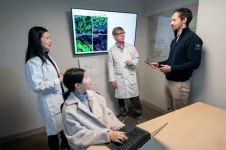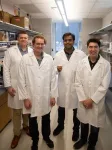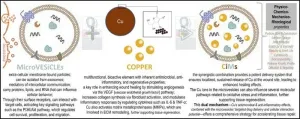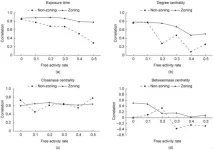(Press-News.org) Neuroblastoma is a solid tumor that occurs in children. When high-risk, the disease has a poor prognosis. Decades ago, adding the drug retinoic acid to neuroblastoma treatment increased survival by 10-15%. However, this effect was only evident in post-chemotherapy consolidation after bulky primary tumors had largely been eliminated. Why retinoic acid is effective in this setting but not against primary tumors, has been speculated about for nearly 50 years. St. Jude Children’s Research Hospital scientists resolved the mystery in a new study, showing retinoic acid uses a novel mechanism to kill metastasized neuroblastoma. The drug “hijacks” a normal developmental pathway to trigger cancer cell death. The findings, which have implications for future combination therapy approaches, were published today in Nature Communications.
“We’ve come up with an explanation for a decades-long contradiction about why retinoic acid works in post-chemotherapy consolidation but has little impact on primary neuroblastoma tumors,” said senior co-corresponding author Paul Geeleher, PhD, St. Jude Department of Computational Biology. “Retinoic acid’s activity heavily depends on the cellular microenvironment.”
The cellular microenvironment is the soup of chemicals, proteins and other signals that surround a cell, and which is unique to that part of the body. For example, the bone marrow microenvironment contains signals to grow blood cells and restructure bone. Metastasized neuroblastoma cells often migrate to bone marrow, where the bone morphogenetic protein (BMP) pathway signaling is highly active. The researchers showed that BMP signaling makes neuroblastoma cells much more vulnerable to retinoic acid.
“Unexpectedly, we found that cells expressing genes from the BMP signaling pathway were very sensitive to retinoic acid,” said co-first and co-corresponding author Min Pan, PhD, St. Jude Department of Computational Biology. “However, since the bone marrow microenvironment causes neuroblastoma cells there to have higher BMP activity, it neatly explained why retinoic acid is very effective at treating those cells during consolidation therapy, but not the primary tumors during up-front treatment.”
Hijacking development to drive metastatic neuroblastoma cell death
Using gene editing technology, the scientists uncovered the relationship between BMP signaling and retinoic acid. They assembled a group of neuroblastoma cell lines susceptible to retinoic acid, then cut out genes to find which were responsible for the drug’s activity. Genes in the BMP pathway had the largest effect while providing a plausible explanation for retinoic acid’s varying outcomes in patients.
“We found that, in neuroblastoma, BMP signaling works with retinoic acid signaling in the same way as during development,” said co-first author Yinwen Zhang, PhD, St. Jude Department of Computational Biology. Zhang characterized how transcription factors, the proteins that bind DNA to regulate gene expression, led to different results in highly retinoic acid-sensitive or insensitive neuroblastoma cells. “If there are a lot of BMP-signaling pathway transcription factors already on DNA, then retinoic acid signaling combines with it to promote downstream cell death–related gene expression. This occurs both in normal embryonic development and neuroblastoma cells in certain microenvironments.”
“We are the first to uncover such an example of ‘hijacking’ a normal embryonic developmental process preserved in cancer that we can exploit therapeutically,” Geeleher said. “Now, we can look for similar processes in other diseases to design less toxic and more effective treatment strategies.”
Authors and funding
The study’s other co-corresponding author is John Easton, of St. Jude. The study’s other authors are William Wright, Xueying Liu, Barbara Passaia, Duane Currier, Jonathan Low, Richard Chapple, Jacob Steele, Jon Connelly, Meifen Lu, Hyeong-Min Lee, Allister Loughran, Lei Yang, Brian Abraham, Shondra Pruett-Miller, Burgess Freeman III, George Campbell, Michael Dyer, Taosheng Chen, Elizabeth Stewart, Selene Koo and Heather Sheppard, all of St. Jude.
The study was supported by grants from the National Institute of General Medical Sciences (R35GM138293), National Cancer Institute (R01CA260060, P30CA021765 and P30CA021765), National Human Genome Research Institute (R00HG009679), and ALSAC, the fundraising and awareness organization of St. Jude.
St. Jude Children's Research Hospital
St. Jude Children's Research Hospital is leading the way the world understands, treats and cures childhood cancer, sickle cell disease, and other life-threatening disorders. It is the only National Cancer Institute-designated Comprehensive Cancer Center devoted solely to children. Treatments developed at St. Jude have helped push the overall childhood cancer survival rate from 20% to 80% since the hospital opened more than 60 years ago. St. Jude shares the breakthroughs it makes to help doctors and researchers at local hospitals and cancer centers around the world improve the quality of treatment and care for even more children. To learn more, visit stjude.org, read St. Jude Progress, a digital magazine, and follow St. Jude on social media at @stjuderesearch.
END
St. Jude scientists solve mystery of how the drug retinoic acid works to treat neuroblastoma
Scientists at St. Jude Children’s Research Hospital have uncovered the mechanism by which retinoic acid selectively kills metastatic neuroblastoma cells, with little effect on primary tumors.
2025-02-28
ELSE PRESS RELEASES FROM THIS DATE:
New device could allow you to taste a cake in virtual reality
2025-02-28
COLUMBUS, Ohio – Novel technology intends to redefine the virtual reality experience by expanding to incorporate a new sensory connection: taste.
The interface, dubbed ‘e-Taste’, uses a combination of sensors and wireless chemical dispensers to facilitate the remote perception of taste – what scientists call gustation. These sensors are attuned to recognize molecules like glucose and glutamate — chemicals that represent the five basic tastes of sweet, sour, salty, bitter, and umami. Once captured via an electrical signal, that data is wirelessly passed to a remote device for replication.
Field ...
Illinois researchers develop next-generation organic nanozymes and point-of-use system for food and agricultural uses
2025-02-28
URBANA, Ill. – Nanozymes are synthetic materials that have enzyme-like catalytic properties, and they are broadly used for biomedical purposes, such as disease diagnostics. However, inorganic nanozymes are generally toxic, expensive, and complicated to produce, making them unsuitable for the agricultural and food industries. A University of Illinois Urbana-Champaign research team has developed organic-material-based nanozymes that are non-toxic, environmentally friendly, and cost effective. In two new studies, they introduce ...
Kicking yourself: Going against one’s better judgment amplifies self-blame
2025-02-28
ITHACA, N.Y. – When people go along with opinions that go against their better judgment, they feel more culpable for the decision if things go wrong than if they hadn’t received another opinion, new research from Cornell University finds.
The effect may seem counterintuitive, but going against one’s better judgment increases thoughts about better decisions that could have been made, which amplify feelings of control over the situation.
“If you have another person in the ...
Rice researchers harness gravity to create low-cost device for rapid cell analysis
2025-02-28
HOUSTON – (Feb. 28, 2025) – A team of researchers at the George R. Brown School of Engineering and Computing at Rice University has developed an innovative artificial intelligence (AI)-enabled, low-cost device that will make flow cytometry ⎯ a technique used to analyze cells or particles in a fluid using a laser beam ⎯ affordable and accessible.
The prototype identifies and counts cells from unpurified blood samples with similar accuracy as the more expensive and bulky conventional flow cytometers, provides results within minutes and is significantly cheaper and compact, making it highly attractive for point-of-care clinical ...
Revolutionary copper-infused microvesicles: a new era in biofunctional medicine
2025-02-28
In a study published today in Biofunctional Materials, Prof. Dr. Haidar, Founder and CEO of BioMAT’X I+D+I LABs in Santiago, Chile, unveils a groundbreaking advancement in dental care: Copper-incorporated microvesicles (CiMs). This innovative technology combines the healing power of copper with microvesicles to enhance tissue regeneration, promote healing, and combat oral diseases. With potential applications in dentistry, cranio-maxillo-facial surgery and beyond, CiMs; a promising leap forward in biomedical technology.
In an exciting breakthrough ...
Primary care practices with NPs are key to increasing health care access in less advantaged areas, Columbia Nursing study shows
2025-02-28
NEW YORK, NY (February 28, 2025) -- Primary care practices that employ nurse practitioners (NPs) are more likely to serve socioeconomically disadvantaged communities than practices with no NPs on staff, Columbia University School of Nursing researchers report in JAMA Network Open. Assistant Professor Monica O’Reilly-Jacob, PhD, led the study, published online February 28, 2025.
To better understand the distribution of NPs—who are increasingly critical to improving access to primary care—O’Reilly-Jacob and her colleagues looked ...
TTUHSC conducting study to help patients that experience traumatic blood loss
2025-02-28
The Texas Tech University Health Sciences Center is conducting a research study that will look at whether calcium, vasopressin, or both early in the course of treatment would help severely injured patients that lose a lot of blood survive their injuries.
The CAlcium and VAsopressin following Injury Early Resuscitation (CAVALIER) trial will include approximately 1,050 people aged 18 to 90. Patients who have traumatic injuries with loss of blood may be enrolled by participating emergency medical personnel during their transportation to the hospital or after arrival to University Medical Center Hospital.
CAVALIER is an Exception from Informed Consent (EFIC) trial, meaning that, the trial ...
Next top model: Competition-based AI study aims to lower data center costs
2025-02-28
NEWPORT NEWS, VA – Who, or rather what, will be the next top model?
Data scientists and developers at the U.S. Department of Energy’s Thomas Jefferson National Accelerator Facility are trying to find out, exploring some of the latest artificial intelligence (AI) techniques to help make high-performance computers more reliable and less costly to run.
The models in this case are artificial neural networks trained to monitor and predict the behavior of a scientific computing cluster, where torrents of numbers are constantly crunched. The goal is to help system administrators quickly identify and ...
Innovative startup awarded $10,000 to tackle cardiovascular disparities
2025-02-28
DALLAS, Feb. 28, 2025 — Cardiovascular disease disproportionately affects Black communities, with more than 57% of non-Hispanic Black adults living with some form of the disease. To drive solutions that address these disparities, the American Heart Association, a global force changing the future of health for all, launched the Heart of Innovation HBCU Challenge to empower the next generation of health tech entrepreneurs from Historically Black Colleges and Universities (HBCUs).
On Monday, Shadrach ...
Study compares indoor transmission-risk metrics for infectious diseases
2025-02-28
A recent study published in the journal Engineering delves into the complex world of assessing the transmission risk of infectious diseases in indoor spaces. With the ongoing impact of the COVID-19 pandemic, understanding how to accurately evaluate the effectiveness of non-pharmaceutical interventions (NPIs) has become crucial.
Governments worldwide implemented NPIs to control the spread of COVID-19. Many studies used simulations to measure the risk of infection transmission before and after implementing these measures. However, the choice of metric to quantify ...
LAST 30 PRESS RELEASES:
Scalable and healable gradient textiles for multi‑scenario radiative cooling via bicomponent blow spinning
Research shows informed traders never let a good climate crisis go to waste
Intelligent XGBoost framework enhances asphalt pavement skid resistance assessment
Dual-function biomaterials for postoperative osteosarcoma: Tumor suppression and bone regeneration
New framework reveals where transport emissions concentrate in Singapore
NTP-enhanced lattice oxygen activation in Ce-Co catalysts for low-temperature soot combustion
Synergistic interface engineering in Cu-Zn-Ce catalysts for efficient CO2 hydrogenation to methanol
COVID-19 leaves a lasting mark on the human brain
Scientists use ultrasound to soften and treat cancer tumors without damaging healthy tissue
Community swimming program for Black youth boosts skills, sense of belonging, study finds
Specific depressive symptoms in midlife linked to increased dementia risk
An ‘illuminating’ design sheds light on cholesterol
Who is more likely to get long COVID?
Study showcases resilience and rapid growth of “living rocks”
Naval Research Lab diver earns Office of Naval Research 2025 Sailor of the Year
New Mayo-led study establishes practical definition for rapidly progressive dementia
Fossil fuel industry’s “climate false solutions” reinforce its power and aggravate environmental injustice
Researchers reveal bias in a widely used measure of algorithm performance
Alcohol causes cancer. A study from IOCB Prague confirms damage to DNA and shows how cells defend against it
Hidden viruses in wastewater treatment may shape public health risks, study finds
Unlock the power of nature: how biomass can transform climate mitigation
Biochar reshapes hidden soil microbes that capture carbon dioxide in farmland
Reducing saturated fat intake shows mortality benefit, but only in high-risk individuals
Manta rays create mobile ecosystems, study finds
Study: Mixed results in using lipoic acid to treat progressive multiple sclerosis
Norbert Holtkamp appointed director of Fermi National Accelerator Laboratory
New agentic AI platform accelerates advanced optics design
Biologists discover neurons use physical signals — not electricity — to stabilize communication
Researchers discover that a hormone can access the brain by hitchhiking
University of Oklahoma researcher awarded funding to pursue AI-powered material design
[Press-News.org] St. Jude scientists solve mystery of how the drug retinoic acid works to treat neuroblastomaScientists at St. Jude Children’s Research Hospital have uncovered the mechanism by which retinoic acid selectively kills metastatic neuroblastoma cells, with little effect on primary tumors.





